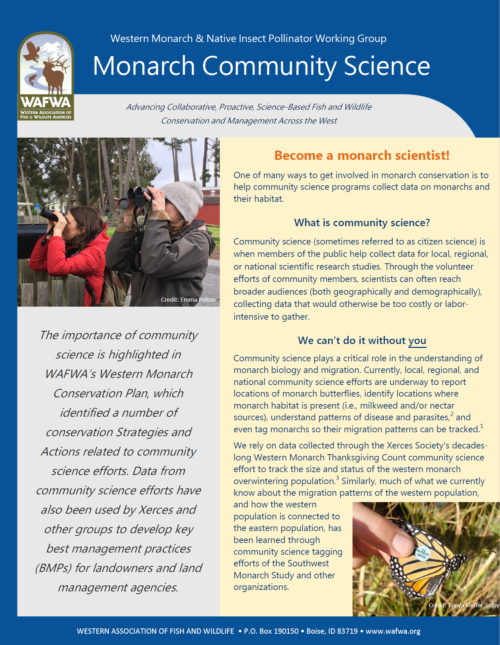Home
›
2023-2026 Work Plan
Posted by WAFWA on November 9, 2023
The goal and purpose of the Western Association of Fish and Wildlife Agencies (WAFWA) Western Monarch and Native Insect Pollinator (WMNIP) working group is to identify and prioritize voluntary strategies and actions with landscape-level benefits to declining populations of insect pollinators. In particular, the 2023 Work Plan aims to benefit…
Read More
Threats to Western Monarchs
Posted by WAFWA on January 11, 2023
Hundreds of groves of native and non-native trees along the coast of California and Baja California, Mexico serve as the winter home for monarchs of the western U.S., yet many of these sites are not formally protected. Since the 1980s, at least 60 overwintering sites have been destroyed by development,…
Read More
Support Monarch Habitat
Posted by WAFWA on January 11, 2023
Nectar is the primary food source of adult monarchs. Nectar creates fat stores that allow monarchs to migrate long distances as well as to survive the winter period.1 Nectar resources are particularly important during the overwintering period as well as the fall migration, when flowering plants tend to be in…
Read More
Monarch Community Science
Posted by WAFWA on January 11, 2023
One of many ways to get involved in monarch conservation is to help community science programs collect data on monarchs and their habitat.
Read More
Keep Western Monarchs Wild
Posted by WAFWA on January 11, 2023
Captive rearing poses the risk of transmitting disease between caterpillars raised in higher densities than they would occur in the wild using materials that may have accumulated parasites and pathogens. While disease and predation are natural parts of the monarch life cycle, it is possible to unintentionally infect multiple generations…
Read More
Keep Monarchs Migrating
Posted by WAFWA on January 11, 2023
Monarchs complete a fascinating, annual, multi-generational migration, returning to the same overwintering sites each fall and staying there through the winter until the next breeding season. Despite intensive study, the monarch’s migration mechanisms remain a mystery that captures the imagination. Although flying hundreds to thousands of miles exacts a high…
Read More
Western monarch butterfly conservation plan, 2019–2069
Posted by WAFWA on July 1, 2019
Overview: Concurrent with the status review, the U.S. Fish and Wildlife Service and the Western Association of Fish and Wildlife Agencies (WAFWA) have actively promoted collaborative efforts across state, organizational, and landownership boundaries to address threats and opportunities facing monarchs and other pollinators. In 2017, the Western Association of…
Read More







